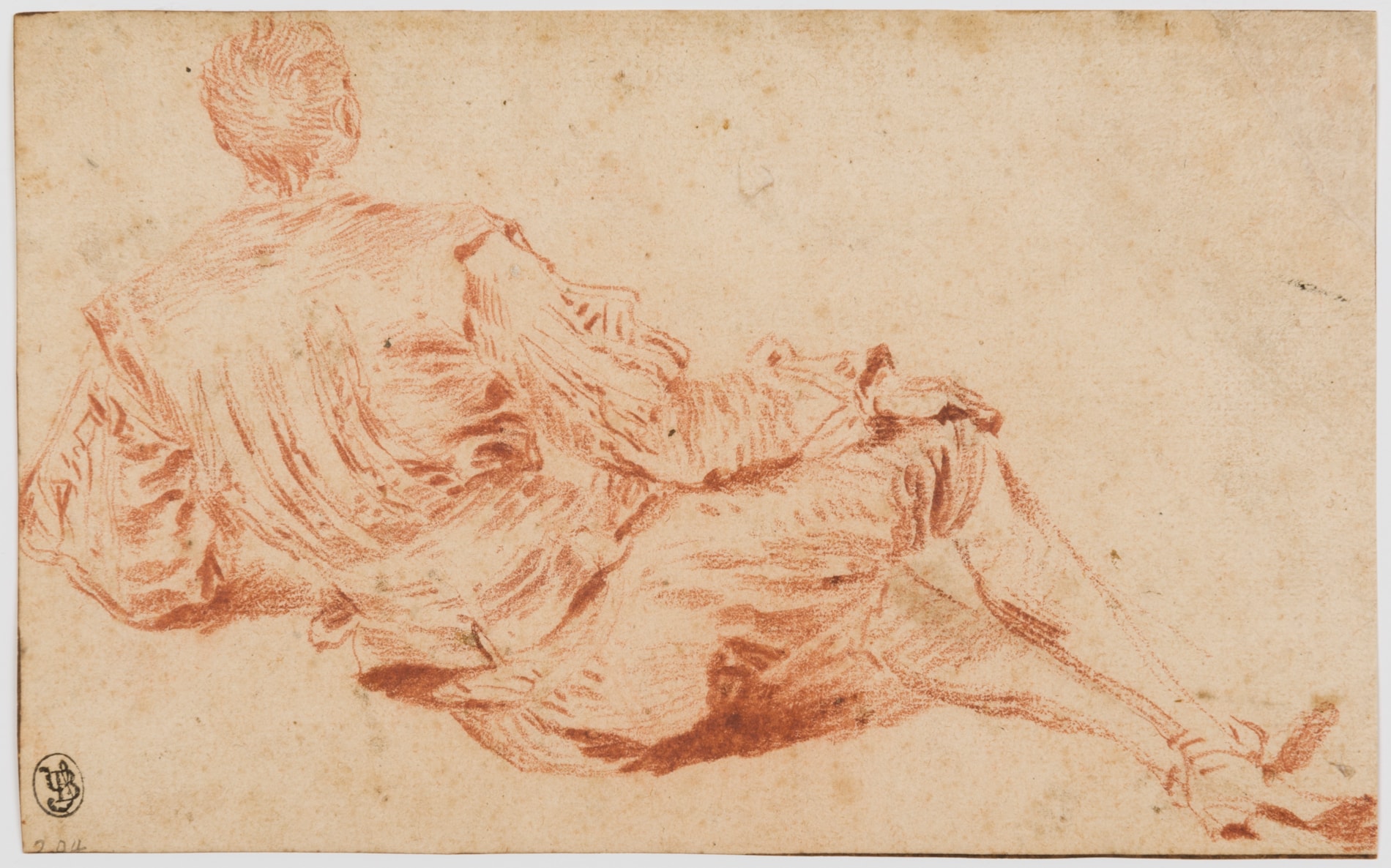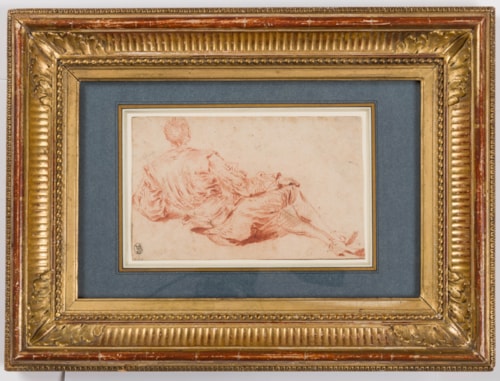Jean-Baptiste PATER
(Valenciennes 1695 - Paris 1736)
A Reclining Man, Seen from Behind
Red chalk.
Made up at the upper right corner.
Numbered 204 [partly cut off] at the lower left.
A French customs stamp on the reverse of the old mount.
A printed label of the Parisian framer and mounter Maurice Hauet on the old backing board.
107 x 173 mm. (4 1/4 x 6 3/4 in.)
Made up at the upper right corner.
Numbered 204 [partly cut off] at the lower left.
A French customs stamp on the reverse of the old mount.
A printed label of the Parisian framer and mounter Maurice Hauet on the old backing board.
107 x 173 mm. (4 1/4 x 6 3/4 in.)
This drawing can be identified as a study for the reclining male figure that appears at the centre right foreground of one of Jean-Baptiste Pater’s finest works, the large painting The Dance of c.1725. The painting was one of a group of fête galantecanvases acquired by Frederick the Great, King of Prussia, for his palace of Sanssoucci at Potsdam, near Berlin, where it remains today as part of the Stiftung Preussische Schlösser und Gärten. (In assembling one of the finest collections of 18th century art in Europe, Frederick the Great – a friend and patron of Voltaire - came to own more than forty paintings by Pater, alongside numerous superb works by Watteau and Nicolas Lancret.) A smaller variant of The Dance by Pater, which includes the same figure near the right edge of the composition, is in the collection of the Worcester Art Museum.
The number 204 at the bottom left of the present sheet indicates that it was once part of an album of over five hundred drawings – the majority by Pater, but also including drawings by Watteau and Claude III Audran – assembled in the second half of the 18th century, and known as the ‘Groult Album’ after it entered the collection of the industrialist Camille Groult (1837-1908), whose impressive collection of paintings, drawings and tapestries was kept in his hôtel particulieron the avenue Malakoff in Paris. His collection then passed to his son, Jean Groult (1868-1951).
Part of the contents of the Groult Album, amounting to around a hundred sheets, were acquired by the Louvre in 1998. This drawing, however, appears to have been removed from the album much earlier, since it is recorded in the exceptional collection of 18th and 19th century French prints and drawings belonging to the Parisian antiquaire Alfred II Beurdeley (1847-1919). While the bulk of the Beurdeley collection was dispersed, after his death, at auction in 1920 and 1921, the present sheet was part of a group of over three hundred 18th century French drawings – including several examples each by François Boucher, Jean-Honoré Fragonard, Nicolas Lancret, Jean-Baptiste Oudry, Hubert Robert, Augustin and Gabriel de Saint-Aubin, Louis-Roland Trinquesse and Antoine Watteau – which were sold from the Beurdeley collection at auction in Paris in 1905.
At the time of the 1905 Beurdeley sale, the present sheet was thought to be by Watteau, and was sold together with a related red chalk drawing of a reclining man, also at the time attributed to Watteau but in fact by Pater. This second drawing from the Beurdeley collection is a study for a figure in Pater’s painting Le Joeur de Lute of c.1720-1725 at Sanssoucci, and is stylistically akin to the present sheet. A similar red chalk drawing by Pater of a reclining man seen from behind, which appeared at auction in London in 1971, has been tentatively related to the Worcester painting.
Among other stylistically comparable drawings by Pater is a red chalk study of two seated men, also at one time part of the Groult Album, in the Musée des Beaux-Arts in Rouen.
The number 204 at the bottom left of the present sheet indicates that it was once part of an album of over five hundred drawings – the majority by Pater, but also including drawings by Watteau and Claude III Audran – assembled in the second half of the 18th century, and known as the ‘Groult Album’ after it entered the collection of the industrialist Camille Groult (1837-1908), whose impressive collection of paintings, drawings and tapestries was kept in his hôtel particulieron the avenue Malakoff in Paris. His collection then passed to his son, Jean Groult (1868-1951).
Part of the contents of the Groult Album, amounting to around a hundred sheets, were acquired by the Louvre in 1998. This drawing, however, appears to have been removed from the album much earlier, since it is recorded in the exceptional collection of 18th and 19th century French prints and drawings belonging to the Parisian antiquaire Alfred II Beurdeley (1847-1919). While the bulk of the Beurdeley collection was dispersed, after his death, at auction in 1920 and 1921, the present sheet was part of a group of over three hundred 18th century French drawings – including several examples each by François Boucher, Jean-Honoré Fragonard, Nicolas Lancret, Jean-Baptiste Oudry, Hubert Robert, Augustin and Gabriel de Saint-Aubin, Louis-Roland Trinquesse and Antoine Watteau – which were sold from the Beurdeley collection at auction in Paris in 1905.
At the time of the 1905 Beurdeley sale, the present sheet was thought to be by Watteau, and was sold together with a related red chalk drawing of a reclining man, also at the time attributed to Watteau but in fact by Pater. This second drawing from the Beurdeley collection is a study for a figure in Pater’s painting Le Joeur de Lute of c.1720-1725 at Sanssoucci, and is stylistically akin to the present sheet. A similar red chalk drawing by Pater of a reclining man seen from behind, which appeared at auction in London in 1971, has been tentatively related to the Worcester painting.
Among other stylistically comparable drawings by Pater is a red chalk study of two seated men, also at one time part of the Groult Album, in the Musée des Beaux-Arts in Rouen.
A native of Valenciennes, like Antoine Watteau, Jean-Baptiste-Joseph Pater spent a brief period as a youthful apprentice in Watteau’s studio in Paris. However, he apparently found the master’s temperament too difficult and eventually decided to return to Valenciennes. He was back in Paris in 1718, and there enjoyed a modestly successful career as a painter of fête galantes of the type made popular by Watteau, with elegant figures in gardens or pastoral settings. Pater was reconciled with Watteau in 1721, shortly before the elder artist’s death, and spent the last month of the master’s life working closely with him; a brief period which, the younger artist later claimed, taught him all that he knew. After Watteau’s death, Pater is thought to have been tasked with completing some of his unfinished paintings. He also inherited commissions from several of Watteau’s major patrons, notably Jean de Jullienne, Jean-Baptiste Glucq and Frederick the Great, King of Prussia. Continuing the tradition of the fête galante, Pater was agrée at the Académie Royale in 1725 and reçu as a peintre des sujets modernes three years later, in 1728, with a painting of Soldiers Merrymaking now in the Louvre; one of only three dated canvases by the artist. Although he painted a few portraits and several military scenes, most of his work was in the form of fêtes galantes; indeed, during his lifetime Pater was sometimes regarded as the equal of Watteau in this genre. He also painted numerous scenes of military encampments and marches, and was granted one Royal commission, in 1736, for a painting for Versailles. Like Watteau, Pater had only a brief career, and died the same year, at the age of forty-one.
Eleven years younger than Watteau, Pater was his only documented pupil, and his familiarity with the master’s drawings is readily evident in his own draughtsmanship. Although his style is indebted to that of Watteau, unlike him Pater drew almost exclusively in red chalk, sometimes with added touches of white heightening. Perrin Stein has noted that ‘In contrast to Watteau’s differentiated textures and sensitivity to underlying form, Pater’s drawings cultivate the decorative potential of the chalk stroke, using a shorthand of short, jabbing marks and wiggly lines to exaggerate effects of vibration and shimmer. Like Watteau, he appears to have had little use for the compositional sketch. Pater’s surviving drawings are almost invariably red chalk studies of single figures – drawings that were apparently retained and reused, judging from the frequent recurrence of certain figures and poses in Pater’s painted oeuvre.’ As Margaret Morgan Grasselli has pointed out, however, ‘Like Watteau, Pater often made drawings with no particular composition in mind, but kept them for possible use in later works. Many of them appear not to have been used in his extant corpus of paintings.’
Eleven years younger than Watteau, Pater was his only documented pupil, and his familiarity with the master’s drawings is readily evident in his own draughtsmanship. Although his style is indebted to that of Watteau, unlike him Pater drew almost exclusively in red chalk, sometimes with added touches of white heightening. Perrin Stein has noted that ‘In contrast to Watteau’s differentiated textures and sensitivity to underlying form, Pater’s drawings cultivate the decorative potential of the chalk stroke, using a shorthand of short, jabbing marks and wiggly lines to exaggerate effects of vibration and shimmer. Like Watteau, he appears to have had little use for the compositional sketch. Pater’s surviving drawings are almost invariably red chalk studies of single figures – drawings that were apparently retained and reused, judging from the frequent recurrence of certain figures and poses in Pater’s painted oeuvre.’ As Margaret Morgan Grasselli has pointed out, however, ‘Like Watteau, Pater often made drawings with no particular composition in mind, but kept them for possible use in later works. Many of them appear not to have been used in his extant corpus of paintings.’
Provenance
Part of an album of drawings, mostly by Jean-Baptiste Pater, possibly the same as that sold anonymously in Douai, 7 July 1772, lot 32 (‘Desseins reliés. 500 Desseins au Crayon rouge en 157. feuilles, par Watteau et Pater’)
Emmanuel Alfred Beurdeley, Paris (Lugt 421)
His sale, Paris, Galerie Georges Petit, 13-15 March 1905, part of lot 277 (as Watteau: Études de Mezzetins…L’un presque couché, vu de dos, accoudé à terre, une main appuyée sur le genou droit. L’autre, assis, vu de dos, la tête retournée de profil à gauche, un bras tendu. Deux dessins à la sanguine. Haut., 11 cent.; larg., l’un 17 cent, l’autre 19 cent. Cadre en bois sculpté.)
Camille Groult, Paris
By descent to his son, Jean Groult, Paris
By descent to his son, Pierre Bordeaux-Groult, Paris
His (anonymous) sale, Paris, Galerie Charpentier, 1-2 April 1954, lot 7
Jacques Bacri, Paris
Thence by descent.
Emmanuel Alfred Beurdeley, Paris (Lugt 421)
His sale, Paris, Galerie Georges Petit, 13-15 March 1905, part of lot 277 (as Watteau: Études de Mezzetins…L’un presque couché, vu de dos, accoudé à terre, une main appuyée sur le genou droit. L’autre, assis, vu de dos, la tête retournée de profil à gauche, un bras tendu. Deux dessins à la sanguine. Haut., 11 cent.; larg., l’un 17 cent, l’autre 19 cent. Cadre en bois sculpté.)
Camille Groult, Paris
By descent to his son, Jean Groult, Paris
By descent to his son, Pierre Bordeaux-Groult, Paris
His (anonymous) sale, Paris, Galerie Charpentier, 1-2 April 1954, lot 7
Jacques Bacri, Paris
Thence by descent.
Literature
Liste des catalogues de ventes consultés où figurent des dessins de Watteau (XVIIIe-XXe siècles), in Pierre Rosenberg and Louis-Antoine Prat, Antoine Watteau: Catalogue raisonné des dessins, Milan, 1996, Vol.II, p.1459.





